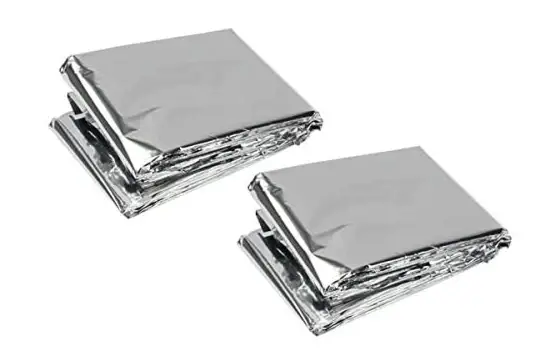Space blankets are a common item found in many emergency preparedness kits because they are small, cheap, light, and useful. Their best-known function is on keeping a subject warm and preventing hypothermia, but you may be wondering if they can serve other purposes.
Do space blankets keep things cold? While a space blanket may slightly aid in reflecting heat away from cold containers such as coolers, this is not its primary purpose. A space blanket is an emergency item designed to keep the human body warm by radiating the person’s body heat back toward them.
A space blanket is primarily designed to keep you warm during an adventure or emergency, and it does this through some pretty cool technology. On top of this function, space blankets can be useful in other situations as well, though keeping warm should be your first priority. The remainder of this article will explain the properties of a space blanket and lists some of its other uses.
About Space Blankets

Space blankets, also called emergency blankets, have many beneficial qualities that make them ideal for storing in your home and car or taking with you on an outdoor adventure.
They are:
- Light – about 3 oz./85 grams
- Cheap – less than $5 each
- Small – about the size of a deck of cards when folded
- Waterproof
Space blankets are also included in many premade emergency kits and are a staple item for backpackers, skiers, off-roaders, and other adventurers. They are used to keep people warm and help prevent or treat shock by keeping a person’s body heat in and the cold out.
Why Space Blankets Don’t Keep Things Cold
The reflective technology of space blankets is effective in protecting the human body from heat loss by using the body’s on heat generation to keep it warm. They also protect the skin from cooling down due to wind chill. However, the blanket itself is very thin, and the plastic material does not insulate as well as other materials such as goose down, cotton batting, or synthetic foam.
Because of these factors, space blankets are not ideal for keeping food or other perishable items cold for any period of time. The reflective side may be turned outward to reflect some amount of sunlight, but this effect should not be relied upon in a time of emergency. Coolers or other insulating containers would perform this function more effectively.
Space Blanket Material

Space blankets are made out of metalized Mylar, a thin plastic sheet coated with a metallic reflecting agent. This material was originally created by NASA in 1964. It was solely used on satellites where the metalized side reflected up to 97% of radiated heat.
Modern space blankets are still made the same way as these early satellite covers. Aluminum vapor is vacuum-deposited onto a thin, durable plastic (usually PET plastic). They always have one reflective side and one non-reflective side.
Where to Buy Space Blankets
Space blankets can be purchased at a number of retailers, both in-store and online. The best place to find them is at any outdoor or sporting goods store. Big-box stores such as Walmart also sell these items, and you can always find them on Amazon.
How Space Blankets Work
In order to understand how to most effectively use a space blanket, it is first important to understand the five different types of heat loss.
Types of Heat Loss
- Convection is when the wind blows over the skin or wet clothing, causing a cooling effect. This type of heat loss can be understood as “wind chill” (i.e., the wind makes it feel colder than it really is). Clothing helps protect the body from the wind chill.
- Conduction occurs when the heat is lost through contact with cooler surfaces than that of the body. Insulating clothing helps prevent this type of heat loss.
- Radiation is the natural occurrence of passively losing heat from all over the body. Any type of clothing can block some amount of heat loss through radiation.
- Evaporation occurs during perspiration. This is the body’s natural cooling system where sweat on the skin evaporates, causing it to cool. This also can happen if the skin becomes wet in some other way (i.e., snow or rain). Clothing that wicks away sweat prevents this type of heat loss by keeping the skin dry.
- Respiration is when the heat is lost through breathing. This is a minor form a heat loss and can be prevented by covering the mouth and nose.
The Role of a Space Blanket in Preventing Heat Loss
Space blankets primarily address heat loss from convection and radiation. They also provide some protection from heat loss by evaporation.
- Heat Loss through Radiation – The design of a space blanket is most effective in preventing heat loss through radiation. When wrapped around a person (ideally on bare skin) with the reflecting side turned inward, it can reflect radiated heat directly back to them. Without a space blanket, this radiated heat would disperse into the air and be lost.
- Heat Loss through Convection – Since plastic is not a breathable material, a space blanket can prevent some heat loss from convection by covering the skin and keeping out the elements of wind and air. The more you’re able to seal the blanket around someone, the more effective this will be. Remember, any crack in the seal will allow air to travel back and forth.
- Heat Loss through Evaporation – While wrapped in a space blanket, you will still sweat. You may even complain that you feel “clammy.” This is a good thing because it means that your sweat is not evaporating from your body and causing further cooling.
However, please keep in mind that space blankets are not effective in preventing heat loss from conduction or respiration.
- Heat Loss through Conduction – Heat loss through conduction could be a major factor during an emergency if you are lying against cold dirt or snow as heat moves from your body into the ground. In these cases, a space blanket will not be effective in blocking the heat loss as it has no insulating properties. If you plan to be in an environment where this type of protection will be necessary, it is recommended that you also pack a thin insulating pad or bivvy sack, such as those described in this article by Traditional Mountaineering.
- Heat Loss through Respiration – While it may be possible to cover the person’s head with the space blanket, you’ll want to keep the nose and mouth free. However, if they are breathing hard, or if heat loss by respiration is a concern, covering the face with a breathable scarf or T-shirt is recommended.
Other Uses for a Space Blanket
During any emergency or adventure situation, the priority should be on staying warm. However, if that is not an immediate concern, space blankets do have other uses.
As an Emergency Shelter
Since space blankets are waterproof, they can act as an emergency shelter or lean-to. As long as the precipitation is not too heavy or prolonged, they will protect you from rain and snow. You can also use the shiny side to reflect a campfire’s heat as long as the campfire is far enough away so as not to melt the plastic.
Signaling for Help
Space blankets can also be used to signal for help in the case where you’re stranded in the wilderness. The reflective side is more visible from their air and can get the attention of potential rescuers. Some brands of space blanket even come with S.O.S. (the Morse code phrase for “help”) printed on one side.
As an Aid to Keep Things Cool
While the blanket itself is an ineffective insulator, the reflective properties can help keep things in direct sunlight cooler than the air around them. Much the way it works on satellites, the reflective side directs sunlight away from your tent or cooler. Preventing the radiation from heating the container up too fast. This effect is intensified if the location is also under shade.
It is also worth noting that if this reflective technique is used to keep your body cool, it should be set up as a shade tent rather than wrapped around you. Since the plastic material is designed to keep heat in, this wrapping process will negate the reflective properties.
Space blankets can also be used with other items in a variety of do-it-yourself projects. Check out this Instructable article on how to make a functional Backpacking Cooler!
